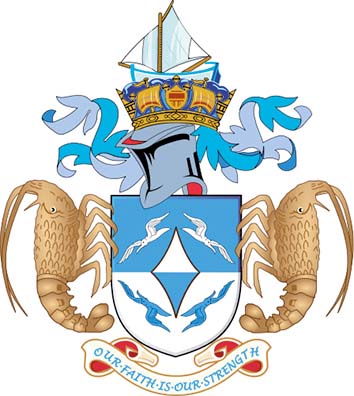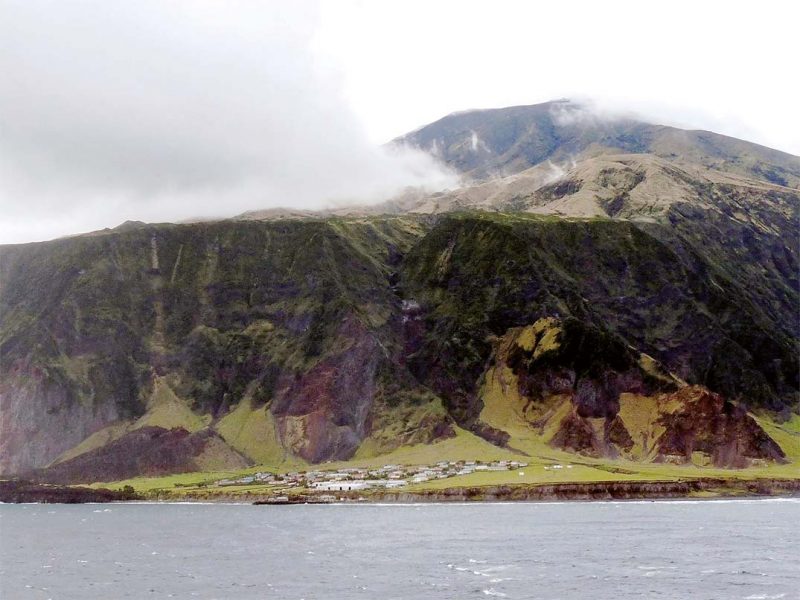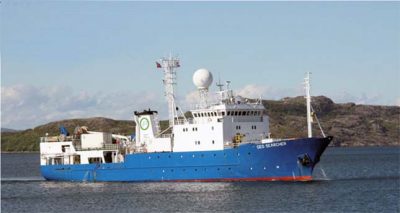Edinburgh-of-the-Seven-Seas

 Sail ho! The cry that once echoed across the most remotest settlement on earth tells a story of a community that will always rely entirely on shipping to link it to the outside world. These are exciting times for the people of Tristan da Cunha. There’s a new lifeline vessel, and there’s a new drive to bring more cruise ships to this jewel of the South Atlantic.
Sail ho! The cry that once echoed across the most remotest settlement on earth tells a story of a community that will always rely entirely on shipping to link it to the outside world. These are exciting times for the people of Tristan da Cunha. There’s a new lifeline vessel, and there’s a new drive to bring more cruise ships to this jewel of the South Atlantic.
200 years after its British settlement, Tristan, home to around 260 UK citizens and to millions of globally-important seabirds, still celebrates its maritime heritage. Pensioners now living in its one settlement, Edinburgh-of-the-Seven-Seas, can clearly recall the days when the sight of a passing ship would trigger a dash to sea in traditional hand-built longboats, to barter meat and knitwear for flour and manufactured goods.
In 2017, this unique island community welcomes the arrival of every vessel, and it faces an unusual challenge. There’s a permanent waiting-list of passengers who want to visit, due to a shortage of available berths.
Tourism co-ordinator Dawn Repetto says “Tristan is a magnificent place to visit. Its culture, wildlife and tranquillity provide something not to be missed. We’re deep in the South Atlantic Ocean, 1,700 miles from Cape Town, and can only be reached by ship. We’re a ‘bucket list’ destination for people who dare to imagine a life without aeroplanes, 5 star hotels and busy streets”.
Discovered in 1506 and inhabited in 1816, Tristan has a remarkable story and many of its people are descended from shipwrecked sailors. The island is 37 square miles in size and is the largest of a group of islands, Inaccessible lying 20 miles to the west, Nightingale 25 miles to the south west and Gough 220 miles to the south. The community is very proud that Inaccessible and Gough are UNESCO World Heritage Sites, a bird watcher’s paradise.
After an especially difficult winter in 1906, and years of hardship since the 1880s, the British government offered to evacuate the island. Those remaining on Tristan held a meeting and decided to refuse, thus deepening the island’s isolation. It was reported that no ships visited from 1909 until 1919, when HMS Yarmouth finally stopped to inform the islanders of the outcome of World War I.
The Shackleton-Rowett Expedition stopped in Tristan for 5 days in May 1922, collecting geological and botanical samples before returning to Cape Town. Of the few ships that visited in the following years were the RMS Asturias, a Royal Mail Steam Packet Company passenger liner, in 1927, and the ocean liners RMS Empress of France in 1928, RMS Duchess of Atholl in 1929, and RMS Empress of Australia in 1935.
On 12th January 1938 by Letters Patent, Britain declared the islands a dependency of Saint Helena, creating the British Overseas Territory of Saint Helena and Dependencies, which also included Ascension Island.
During the Second World War, Britain used the islands as a secret Royal Navy weather and radio station codenamed HMS Atlantic Isle, to monitor Nazi U-boats (which were required to maintain radio contact) and shipping movements in the South Atlantic Ocean.
The Duke of Edinburgh, the husband of Queen Elizabeth II, visited the islands in 1957 as part of a world tour onboard the royal yacht Britannia.
On 10th October 1961, the eruption of a small volcano to the eastern side of the settlement forced the evacuation of the entire population of 264 individuals. The islanders took to the water in open boats where they were picked up by the fishing vessels Tristania and Frances Repetto where they were taken to Nightingale Island. There they were picked from there up by the Dutch passenger liner Tjisadane that took them to Cape Town, and they travelled on to the UK on the Stirling Castle. HMS Leopard arrived from the Cape on October 13th to find that red-hot lava and smoke were pouring out of the mound, which was 250ft (80m) high. The crew collected as many of the islanders’ belongings as they could before sailing back to South Africa, but all the farm animals and domestic pets had to be left behind.
After a brief spell in wooden huts in Surrey, they were housed at a former RAF camp at Calshot, near Southampton, where they suffered unhappily through an unusually cold English winter. A Royal Society expedition in 1962 found that, although the Tristan crawfish cannery was no more and the islanders’ dogs had taken a heavy toll on the sheep, conditions seemed not impossible. An advance party returned to Tristan in April 1963 and in November some 200 people, including four Tristan girls who had meantime married Englishmen, returned to their island.
Getting to Tristan is a challenge in itself, due to the limited number of visiting ships, but it’s not impossible. The ships that grace Tristan waters today are:-
Baltic Trader
Ovenstone operate the Tristan da Cunha fishery, and as part of the contract with the Tristan Government, operate a regular shipping service of 8 trips a year from Cape Town to Tristan da Cunha and back. Baltic Trader replaced MV Kelso in 2009. Both ships can carry up to 12 passengers.
The Baltic Trader was built in 1975 by Ørens MV at Tronheim as the Lysfoss for Lys-Line. In 1983 she became Tinto before joining Ovenstone in 2009.
Edinburgh
She visits 8/9 times a year but with only 12 berths available, sourcing a trip can be very difficult. She was replaced this year as the island’s main fishing ship.
The Edinburgh was built in 1970 by Slippstodin at Akureyri, Iceland as the Hekla for the Icelandic Government. In 1984 she was converted into a fish factory ship, and in 1987 she was renamed Edinburgh after the Tristan da Cunha capital Edinburgh-of-the-Seven-Seas. She has a crew of 35 and could carry 12 passengers until she was replaced by the Geo Searcher earlier this year.
Edinburgh will be retained by the fishing company, to be used on dedicated cargo trips and for limited fishing.
SA Agulhas II
The SA Agulhas II provides a cargo and passenger service to Tristan da Cunha each spring, normally departing Cape Town in early September. This is part of a lease agreement on Gough Island to the South African Government where they maintain a Meteorological Station. So the ship travels out to Tristan, then on to Gough for the annual exchange of personnel and cargo supply. The voyage gives passengers an opportunity to have a stay of about three weeks on Tristan, making it a very popular, and busy trip for visitors since the early visits by South African Naval Frigates, then the RSA from the 1960s followed by SA Agulhas from 1978-2011, and now SA Agulhas II. The SA Agulhas II also services bases on Marion Island and SANAE IV Antarctica in a busy annual programme.
Ordered to replace the ageing SA Agulhas by the South African Government in 2009 it was constructed in Rauma, Finland between September 2010 and its launch on 21st July 2011. It was fitted out and completed by April 2012.

SA Agulhas II is designed as a Polar Supply and Research Vessel and in Arctic sea trials successfully navigated ice up to 0.6m or 2 feet thick.
She has both onboard laboratories for scientific research as well as cargo holds and tanks for supplies for South African polar research stations. In addition she has accommodation for 100 passengers in 46 cabins and facilities such as gym, library, business centre and a 100-seat auditorium.
Aboard are eight permanent and six containerised laboratories for different fields of marine, environmental, biological and climate research totaling 800m2. Deep-water probes can be launched either via a large door in the side of the vessel or, if the ship is operating in ice-infested waters, through a 2.4-by-2.4-metre ‘moon pool’. A drop keel containing transducers for the measurement of plankton density and ocean currents can be lowered 3 metres below the bottom of the ship. A hydraulic A-frame in the stern of the ship can be used to tow sampling nets and dredges.
In order to transport supplies to polar research stations, the ship has a 4,000m3 cargo hold located in the bow of the vessel. It is served by a 35-ton main crane and three 10-ton general cargo cranes, all of which can also be used to lower scientific equipment and vehicles on ice. When heavy loads are being lifted, a heeling tank is used to balance the vessel. S. A. Agulhas II is the first ship of her kind to be allowed to carry both passengers and fuel, such as polar diesel, Jet A helicopter fuel and petrol, as cargo
SA Agulhas II has a hangar and helideck capable of serving two Atals Oryx or Puma helicopters. She also has two fast rescue craft, which are on standby during helicopter operations, and two fully enclosed lifeboats for 75 personnel.
Her ice class, PC-5 means that she is designed for year-round operation in medium first-year ice. Her decks are heated to prevent ice accumulation in temperatures as low as -35°C. SA Agulhas II is the first ship of her kind to be built to the new SOLAS 2009 rules for passenger ships, leading to several unique aspects in her design.
SA Agulhas II is powered by four diesel generating sets, each producing 3,000 kW (4,000 hp). In order to fulfil international maritime regulations the main engines are located in two separate engine rooms and the ship is capable of returning to port with one engine room flooded. In case of emergency electricity is provided by an emergency diesel generator.
The ship has 4.5-metre (15 ft) controllable pitch propellers, giving a maximum speed of 16 knots in open water, but her service speed is slightly lower, and at 14 knots and her operating range is 15,000 nautical miles.
Geo Searcher
A major development for 2017 is the arrival of a new passenger/fishing ship called the Geo Searcher. She was built in 1982 and refurbished in 2005 and 2014. At 1,863 gross tons and 69 metres in length, she served as a scientific research vessel. In 2016 the ship was converted in Gdansk to a factory freezer vessel with cargo and passenger capacity. The Geo Searcher underwent her final conversion work (installation of the lobster tank facility) in Cape Town before making her inaugural voyage to the island in March 2017.
Cruise ships
A few expedition cruise ships visit December-April and give another opportunity to visit, if only for a day or two. Cruise companies in recent years like Lindblad Expeditions, Silversea and Oceanwide Expeditions (one of the longest-established visitors) have taken the opportunity to plan their cruise itineraries to the island. The island aims to attract new arrivals such as Ponant and Regent Seven Seas within the next 18 months when they call with their new vessels. Dawn is working hard with the major companies to promote the “remotest island community in the world” to see how they can link itineraries with their South American, South Atlantic or South African voyages.
Cruise ships that have visited Tristan in the recent past include, Bremen, Corinthian II, Europa, the schooner Gulden Leeuw, Hanseatic, Island Sky, National Geographic Explorer, Ortelius, Plancius, Silver Explorer, and the Queen Mary 2.
OTHER RECENT SHIPS THAT NO LONGER SERVE THE ISLAND
Kelso
The 1,513gt Kelso was built in 1971 by Hayashikane Shipbuilders at Nagasaki as the trawler Toko Maru for Eurex Ltd. Kelso has a crew of 38 and could carry 12 passengers. Kelso was withdrawn from Tristan service after being sold in 2009 and converted into a yacht with the unlikely name of Titanic. She is seen here departing Cape Town for Tristan da Cunha in January 1997.
SA Agulhas
The vessel is a purpose-built ice-strengthened Antarctic Supply & Oceanographic Research Vessel, built in 1977 by Mitsubishi, at Shimonoseki.
The ship is operated by the South African Government’s Department of Environmental Affairs & Tourism, Directorate: Antarctica and islands. SA Agulhas’ last Tristan-Gough voyage was in 2011 as it was replaced for 2012 by SA Agulhas II.
St. Helena
The 6,767gt RMS St Helena is the only ocean-going Royal Mail Ship and one of only two remaining passenger-cargo liners. It has 56 officers and crew and can carry 156 passengers. Built in 1990 by A. & P. Appledore at Aberdeen, it is rated A1+ at Lloyds, is British registered, and has a travelling doctor. Facilities include a swimming pool, library, licensed lounges and a restaurant providing full board including a 6 course dinner. She was due to be withdrawn last year but remains in service on the Cape Town-St. Helena- Ascension service due to the problems with the new airport in St. Helena.
Dawn Repetto reflects that there’s never a lack of people interested in visiting her island, but she recognises the logistical challenges faced by vessel operators. “Ships cannot berth in our harbour as it’s too small, so they have to anchor offshore, and small boats are then used to ferry in visitors. The weather can be against them, making landings at the island difficult”.
However, having outlined the challenges, Tristan da Cunha is a unique place with the lifestyle of a bygone age, and is a hugely sought-after destination. Visitors to Tristan glimpse a self-sufficient island full of equality where islanders:-
- plant and harvest their staple crop of potatoes
- tend livestock to ensure sufficient amounts of beef, lamb and fresh milk
- catch fresh fish from the sea for their own tables
- have no need of credit or debit cards, all wages being paid in cash by the only bank
- suffer from no poverty or crime
- have only one pub, one supermarket, one school and one hospital
- have no restaurants or hotels
- suffer no pollution, so night skies are clear and starry
Tristan is blessed with globally-important wildlife. With two outer islands, Nightingale and Inaccessible (World Heritage Site) close by, visitors can see:-
- Rockhopper penguins
- Albatrosses
- Finches
- Shearwaters
- Seals
- Marine life
- Flora and Fauna
For the lucky traveller who steps ashore on Tristan da Cunha, there’s plenty to see and do:-
- Walking tours of the settlement of Edinburgh, 1961 Volcano and Potato Patches to hear about the island’s history and culture.
- Tour St. Mary’s School, nurturing fewer than 30 children who represent the island’s future.
- Tour the lobster factory to hear how Tristanians catch, process and export the delicious gourmet lobster that is the mainstay of the island economy.
- Visit Nightingale and Inaccessible Islands to see the immense wildlife.
- Beach or deep water fishing – a great opportunity to catch some of our lovely fish from pristine Atlantic waters.
- Mountain walks to Queen Mary’s Peak (highest point 6,760ft/2,060m) or The Base (2,000ft/600m high).
- Round of Golf on our nine hole course shared with some of Tristan’s livestock.
- Visit the traditional Thatched House Museum, which gives an opportunity to see what homes were like before the volcanic eruption in 1961.
- Novelty tractor ride around the settlement of Edinburgh giving great vantage points.
- Explore the ‘British Garrison’ Geocaching Trail.
- Visit the Post & Tourism Centre, Albatross Bar, Rockhopper Gift Shop and Island Supermarket to purchase food, drink, souvenirs and postcards.
- If you’re the sort to hike at leisure then self-guided leaflets are available just for you.
- Wonderful scenery which is breathtaking all in itself
Dawn says, “although Tristan is small and remote, we feel that we can cater for everyone’s needs and if you aren’t the physical type we can offer leisurely excursions or a more bespoke visit. Trust me, Tristan is a destination not to be missed!”.
With the arrival of the MV Geo Searcher, and the added focus on attracting cruise visits, 2017 looks set to herald a new chapter in the shipping history of this unique community.













Comments
Sorry, comments are closed for this item